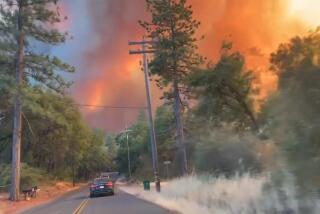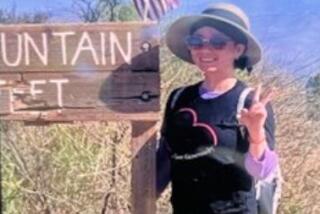Survivalist’s bunker: Trail of clues led to Peter Keller hideout
SEATTLE -- It was a bunker for one that survivalist Peter Keller built deep in a forested hillside in Washington state, according to police who have closely examined the elaborate shelter where Keller retreated after killing his wife and teenage daughter.
“He had pulleys that he would use to move timber. From what I understand, it was three levels. It was reinforced by logs which it appeared as though he hand cut and debarked. It was almost like a log cabin underground,” Sgt. Cindi West of the King County Sheriff’s Department told The Times on Tuesday.
“But from what I understand, it appears as though it was built for one,” she said.
Sheriff’s detectives tracked Keller — who reportedly had been preparing for “the end of the world” — from the smoke-filled death house he had shared with his family in the town of North Bend to the scene of his own last stand in the woods in a remarkable saga of detective work, both the old-fashioned shoe leather kind and the high-tech surveillance variety.
The search began after police were called to the scene of a massive house fire on April 22. They found the bodies of Lynnette Keller, 41, Keller’s wife of 21 years, and their daughter Kaylene, a student at a local community college. Both had been shot in the head, as had the family dog and cat, before the house was torched with a large container of gasoline set alight on the kitchen stove.
Interviewing Kaylene’s boyfriend, detectives learned that Peter Keller had built a survival shelter in preparation for “the end of the world.” Keller’s co-workers at a solar company said he spent a lot of time in the woods — but no one knew quite where.
The co-workers said Keller had arranged to take some time off and had indicated he might not be back at work the following week.
“They said he had a fascination with trains and guns, that he had a survivalist mentality and distaste for authority. They said he would likely fight if confronted by police. They said he spent most of his free time in the woods,” police said in an affidavit filed with the court.
Authorities then checked Keller’s cellphone records, which showed his last call was made about two nights before the slayings — several miles from the ultimate location of the bunker, according to court documents.
After the fire died down, authorities recovered several computers and compact discs from the house, on which they found photos of the bunker while it was under construction, West said.
“One of the photos looked like it was taken from the bunker, pointing away from the mountain. One of our detectives enhanced it, and he believed he was looking at an area not far from where the Kellers lived in North Bend,” West said. The detective did a forensic comparison with a photo taken in the same area and pinpointed the place from which it probably originated.
From there, she said, two police trackers disguised as hikers — in case Keller was using a scope to monitor the outside — moved through the area near Rattlesnake Ridge thought to contain the bunker.
They were able to close in, though, only when a police sergeant in North Bend looked up at the nearby hillside and saw a puff of smoke.
“They pinpointed the area, diverted our SWAT team from where they’d been searching and they found the bunker,” West said.
Police surrounded the rustic underground structure for 22 hours before blowing off its top with explosives. A body believed to be Keller’s was inside, dead of a self-inflicted gunshot wound.
Police found a multilevel structure equipped with pulleys for hauling in heavy lumber and boxes. It was outfitted with food, sodas, propane tanks, a small generator, police scanner, radio, binoculars — and a large number of weapons and ammunition. Police also found two bulletproof vests and some cash.
“It appeared as though he was planning on just living his life there,” West said. Photos found at the house suggested Keller had begun building the bunker in 2004.
The fact that police were able to find it, she said, was because “there were a lot of things on our side,” including the recovery of so many clues from the house.
“It was totally amazing. Hopefully somebody will write a book about it.”
ALSO:
Protesters smash bank, shop windows in Seattle
Explosion ends bunker standoff in Washington state
Five arrested in alleged terrorist plot to blow up Cleveland bridge
More to Read
Sign up for Essential California
The most important California stories and recommendations in your inbox every morning.
You may occasionally receive promotional content from the Los Angeles Times.









